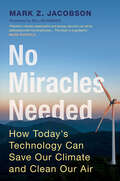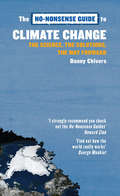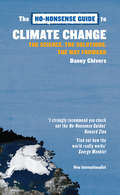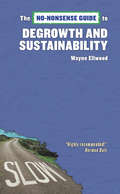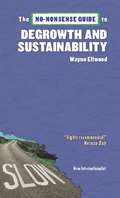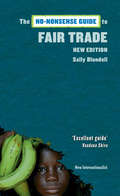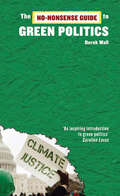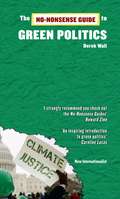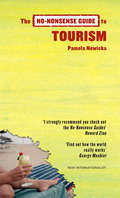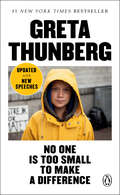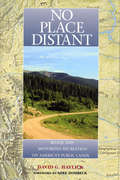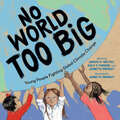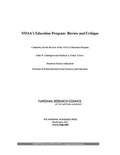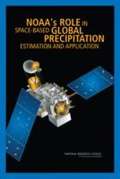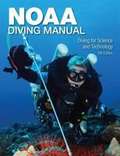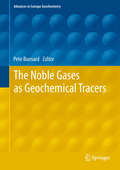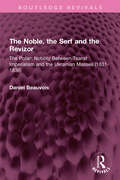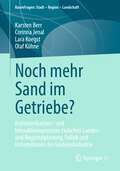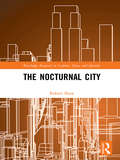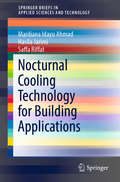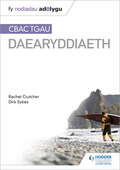- Table View
- List View
No Miracles Needed: How Today's Technology Can Save Our Climate and Clean Our Air
by Mark Z. JacobsonThe world needs to turn away from fossil fuels and use clean, renewable sources of energy as soon as we can. Failure to do so will cause catastrophic climate damage sooner than you might think, leading to loss of biodiversity and economic and political instability. But all is not lost! We still have time to save the planet without resorting to 'miracle' technologies. We need to wave goodbye to outdated technologies, such as natural gas and carbon capture, and repurpose the technologies that we already have at our disposal. We can use existing technologies to harness, store, and transmit energy from wind, water, and solar sources to ensure reliable electricity, heat supplies, and energy security. Find out what you can do to improve the health, climate, and economic state of our planet. Together, we can solve the climate crisis, eliminate air pollution and safely secure energy supplies for everyone.
No Monkeys, No Chocolate
by Melissa Stewart Allen YoungEveryone loves chocolate, right? But how many people actually know where chocolate comes from? How it’s made? Or that monkeys do their part to help this delicious sweet exist?This delectable dessert comes from cocoa beans, which grow on cocoa trees in tropical rain forests. But those trees couldn’t survive without the help of a menagerie of rain forest critters: a pollen-sucking midge, an aphid-munching anole lizard, brain-eating coffin fly maggots—they all pitch in to help the cocoa tree survive. A secondary layer of text delves deeper into statements such as "Cocoa flowers can’t bloom without cocoa leaves . . . and maggots," explaining the interdependence of the plants and animals in the tropical rain forests. Two wise-cracking bookworms appear on every page, adding humor and further commentary, making this book accessible to readers of different ages and reading levels.Back matter includes information about cocoa farming and rain forest preservation, as well as an author’s note.
No-Nonsense Guide to Climate Change: The Science, the Solutions, the Way Forward (No-Nonsense Guides #3)
by Danny ChiversJust as the need for action on climate change becomes more urgent and overwhelming, the campaign to deny that humans are causing it has gained more traction. This completely new book meets the skeptics head on, offering a guide to the science, an insight into the politics of climate justice and a clear sense of the way forward. This is an ideal offering for students, academics and anyone interested in the growing issue of society’s impact on climate change and how to make climate justice a reality.
The No-Nonsense Guide to Climate Change
by Danny ChiversJust as the need for action on climate change becomes more urgent and overwhelming, the campaign to deny that humans are causing it has gained more traction. This completely new book meets the sceptics head on, offering a guide to the science, an insight into the politics of climate justice and a clear sense of the way forward.
No-Nonsense Guide to Degrowth and Sustainability
by Wayne EllwoodThe world’s addiction to economic growth continues with barely any recognition that this is a problem. Indeed, in a Western world currently dominated by austerity measures and ducking in and out of recession, growth is seen even by progressives as the only possible solution for our economic and social woes. This No-Nonsense Guide looks deeper into the idea of economic growth–to trace its history and understand why it has become so unchallengeable and powerful. And then it goes beyond that to present the alternative–how we can kick our dirty habit, how degrowth can be turned into a positive and how we can arrive at a new levels of environmental sustainability without having to turn the clock back to the Dark Ages.
The No-Nonsense Guide to Degrowth and Sustainability
by Wayne EllwoodThis guide explores the idea of economic growth, tracing its history and questioning why it has become so unchallengeable and powerful when unlimited growth in a finite world is ultimately impossible. It illustrates how economics based on degrowth can be turned into a positive and how we can arrive at new levels of environmental sustainability without having turning the clock back to the Dark Ages. A title for anyone interested in economics, the psychology of consumerism and progressive change.Wayne Ellwood is former co-editor of New Internationalist magazine. He is author of the No-Nonsense Guide to Globalization (over fifty thousand sold).
The No-Nonsense Guide to Fair Trade
by Sally BlundellAn in-depth look at two decades of a movement that aims to challenge the ethical foundations of the global market.Transnational corporations look for the cheapest suppliers, while the fair trade movement insists on a premium for the producers at the start of the chain.Sally Blundell uncovers the origins of fair trade and what it is likely to become.
No-Nonsense Guide to Green Politics (No-Nonsense Guides #13)
by Derek WallClimate chaos and pollution, deforestation and consumerism: the crisis facing human civilization is clear enough. But the response of politicians has been cowardly and inadequate, while environmental activists have tended to favour single-issue campaigns rather than electoral politics. The No-Nonsense Guide to Green Politics measures the rising tide of eco-activism and awareness and explains why this event heralds a new political era worldwide: in the near futurethere will be no other politics but green politics.
The No-Nonsense Guide to Green Politics
by Derek WallClimate chaos and pollution, deforestation and consumerism: the crisis facing human civilization is clear enough. But the response of politicians to it has been cowardly and inadequate, while environmental activists have tended to favor single-issue campaigns rather than electoral politics.The No-Nonsense Guide to Green Politics measures the rising tide of eco-activism and awareness and explains why it heralds a new political era worldwide.Derek Wall is a former principal speaker of the British Green Party. He is the author of numerous books, including Babylon and Beyond: The Economics of Anti-Capitalist, Anti-Globalist and Radical Green Movements.
The No-Nonsense Guide to Tourism
by Pamela NowickaThis guide demystifies the often invisible impacts of global tourism, one of the biggest industries in the world, from labor conditions to development by stealth, to the role of elites and the cultural impacts on both the visitor and the visited.It also takes in themes such as the gap year and the role of travel and vacations in Western cultures, and examines the "happy smiling faces" syndrome and asks whether this is just a reworking of old colonial relationships. Pamela Nowicka is a journalist and consultant writing on numerous tourism and ethics subjects.
No One Is Too Small to Make a Difference: Expanded Edition
by Greta ThunbergThe groundbreaking speeches of Greta Thunberg, the young climate activist who has become the voice of a generation, including her historic address to the United Nations <P><P>In August 2018 a fifteen-year-old Swedish girl, Greta Thunberg, decided not to go to school one day in order to protest the climate crisis. Her actions sparked a global movement, inspiring millions of students to go on strike for our planet, forcing governments to listen, and earning her a Nobel Peace Prize nomination. <P><P>No One Is Too Small to Make A Difference brings you Greta in her own words, for the first time. Collecting her speeches that have made history across the globe, from the United Nations to Capitol Hill and mass street protests, her book is a rallying cry for why we must all wake up and fight to protect the living planet, no matter how powerless we feel. Our future depends upon it.
No Ordinary Man: George Mercer Dawson 1849-1901
by Lois Winslow-Spragge Bradley LocknerGeorge Mercer Dawson was indeed no ordinary man. Born in 1849, son of the first Principal of McGill University, Dawson defied health circumstances that would have defeated many people and went on to become one of our most exceptional Canadians. As a geologist in the British North American Boundary Commission between Canada and the U.S.A. and as Director of the Geological Survey of Canada in 1895, Dawson examined and explored every aspect of Canada’s unknown territories. This collection of writings, letters, diaries and essays begins with the young George and moves through his developing years to his adult life. "He climbed, walked and rode on horseback over more of Canada than any other member of the Geological Survey of Canada at that time – yet to look at him, one would not think him capable of a day’s hard physical labour …. It was his hand that first traced upon vacant maps the geological formations of the Yukon and much of British Columbia."- Lois Winslow-Spragge". To read about him is like taking a drink of water from a cool, unpolluted spring. His sense of values was so great that he once said he didn’t care much for money or possessions. All he wanted was what he could hold in his canoe."- Anne Byers, Ottawa
No Place Distant: Roads and Motorized Recreation on America's Public Lands
by Michael P. Dombeck David HavlickWhile many of the roads on public lands provide a great service with relatively little harm, others create significant problems -- from habitat fragmentation to noise pollution to increased animal mortality -- with little or no benefit.In No Place Distant, author David Havlick presents for the first time a comprehensive and in-depth examination of the more than 550,000 miles of roads that crisscross our national parks, national forests, Bureau of Land Management lands, and wildlife refuges, considering how they came to be; their ecological, financial, and societal costs; and what can be done to ensure that those roads are as environmentally benign and cost-effective as possible, while remaining functional and accessible. The book: places the profusion of roads on our public lands in historical context offers an overview of the ecological effects of roads explores the policies, politics, and economics that have fostered road-building on public lands considers the contentious topic of motorized recreation examines efforts to remove roads and restore degraded lands to healthBringing together an impressive range and depth of information along with a thoughtful analysis of the issues, No Place Distant offers a definitive look at the debate over roads on public lands. With its well-crafted prose and extensive documentation, it is an unparalleled resource for anyone concerned with the health or management of public lands in the United States.
No World Too Big: Young People Fighting Global Climate Change
by Lindsay H. Metcalf Jeanette Bradley Keila V. DawsonFans of No Voice Too Small will be inspired by young climate activists who made an impact around climate change in their communities, countries, and beyond.Climate change impacts everyone, but the future belongs to young people. No World Too Big celebrates twelve young activists and three activist groups on front lines of the climate crisis who have planted trees in Uganda, protected water in Canada, reduced school-bus climate footprint in Indonesia, invented alternate power sources in Ohio, and more. Fourteen poems by Vanessa Brantley-Newton, David Bowles, Rajani LaRocca, Renée LaTulippe, Heidi E. Y. Stemple, and others honor activists from all over the world and the United States. Additional text goes into detail about each activist's life and how readers can get involved.
NOAA's Education Program: Review and Critique
by National Research Council of the National AcademiesThere is a national need to educate the public about the ocean, coastal resources, atmosphere and climate. The National Oceanic and Atmospheric Administration (NOAA), the agency responsible for understanding and predicting changes in the Earth's environment and conserving and managing coastal and marine resources to meet the nation's economic, social and environmental needs, has a broad mandate to engage and coordinate education initiatives on these topics. Since its creation in 1970, the NOAA has supported a variety of education projects that cover a range of topics related to the agency's scientific and stewardship mission. NOAA uses formal and informal learning environments to enhance understanding of science, technology, engineering and mathematics (STEM) and to advance environmental education. The work of this agency overlaps and compliments the missions of other federal agencies, institutions of higher education, private and nonprofit organizations. Coordination among these agencies and organizations has been challenging. Limited education resources and the inherently global nature of NOAA's mission make strategic partnerships critical in order for the agency to accomplish its goals. Additionally, clear education goals, planning, and strategic use of resources are critical aspects for effective partnerships. NOAA's Education Program: Review and Critique provides a summary of the national education context for NOAA's role in education which is twofold: first is to advance the environmental literacy of the nation, and second is to promote a diverse workforce in ocean, coastal, Great Lakes, atmospheric and climate sciences. The book also describes the strengths and weaknesses of the education strategic plan, the education evaluation approach of the agency and strategies for improving the evaluation process.
NOAA's ROLE IN SPACE-BASED GLOBAL PRECIPITATION ESTIMATION AND APPLICATION
by National Research Council of the National AcademiesThe National Oceanic and Atmospheric Administration (NOAA) uses precipitation data in many applications including hurricane forecasting. Currently, NOAA uses data collected from the Tropical Rainfall Measuring Mission (TRMM) satellite that was launched in 1997 by NASA in cooperation with the Japan Aerospace Exploration Agency. NASA is now making plans to launch the Global Precipitation Measurement (GPM) mission in 2013 to succeed TRMM, which was originally intended as a 3 to 5 year mission but has enough fuel to orbit until 2012. The GPM mission consists of a "core" research satellite flying with other "constellation" satellites to provide global precipitation data products at three-hour intervals. This book is the second in a 2-part series from the National Research Council on the future of rainfall measuring missions. The book recommends that NOAA begin its GPM mission preparations as soon as possible and that NOAA develop a strategic plan for the mission using TRMM experience as a guide. The first book in the series, Assessment of the Benefits of Extending the Tropical Rainfall Measuring Mission (December 2004), recommended that the TRMM mission be extended as long as possible because of the quality, uniqueness, and many uses of its data. NASA has officially extended the TRMM mission until 2009.
NOAA Diving Manual: Diving for Science and Technology
by Noaa Diving ProgramThis sixth edition of the NOAA Diving Manual builds on earlier editions, combining new developments in equipment and cutting-edge methods and procedures to provide a reference text that is useful for not only scientists but also all divers. New Chapters include: advanced platform support diving with ROVs/AUVs, submersibles, and atmospheric diving systems as well as underwatepPhotography and videography. Significantly revised and updated chapters include diving equipment; procedures for scientific dives, rebreathers, and polluted water diving. This edition also includes the new NOAA nitrox tables.
The Noble Gases as Geochemical Tracers
by Pete BurnardThe twelve chapters of this volume aim to provide a complete manual for using noble gases in terrestrial geochemistry, covering applications which range from high temperature processes deep in the Earth's interior to tracing climatic variations using noble gases trapped in ice cores, groundwaters and modern sediments. Other chapters cover noble gases in crustal (aqueous, CO2 and hydrocarbon) fluids and laboratory techniques for determining noble gas solubilities and diffusivities under geologically relevant conditions. Each chapter deals with the fundamentals of the analysis and interpretation of the data, detailing sampling and sampling strategies, techniques for analysis, sources of error and their estimation, including data treatment and data interpretation using recent case studies.
The Noble Gases as Geochemical Tracers (Advances in Isotope Geochemistry)
by Pete BurnardThe twelve chapters of this volume aim to provide a complete manual for using noble gases in terrestrial geochemistry, covering applications which range from high temperature processes deep in the Earth’s interior to tracing climatic variations using noble gases trapped in ice cores, groundwaters and modern sediments. Other chapters cover noble gases in crustal (aqueous, CO2 and hydrocarbon) fluids and laboratory techniques for determining noble gas solubilities and diffusivities under geologically relevant conditions. Each chapter deals with the fundamentals of the analysis and interpretation of the data, detailing sampling and sampling strategies, techniques for analysis, sources of error and their estimation, including data treatment and data interpretation using recent case studies.
The Noble, the Serf and the Revizor: The Polish Nobility Between Tsarist Imperialism and the Ukrainian Masses (1831-1836) (Routledge Revivals)
by Daniel BeauvoisFirst published in 1991, The Noble, the Serf and the Revizor is a historical and sociological study of the Polish nobility of the Western Ukraine between the two great uprisings that shook Poland in the 19th century is based almost entirely on original, unpublished documents. Daniel Beauvois throws an entirely new light on the Polish nobility of the Ukraine, on its development and particular mentality. Furthermore, his research reveals mechanisms of domination and assimilation, which the Czarist bureaucracy can be said to have pioneered long before the Soviet empire. During this period, the Russian revizor, a key figure in the social drama described in these pages, ruthlessly lowered the status of the majority of the Polish nobles in the Ukraine. Thereafter, their fate was defined by two basic realities: poverty and the decline of their national identity and social status. Only a small minority of rich landowners survived. The price they paid was total political subservience, a subservience which gave rise to an increasingly conservative mentality and the loss of all real contact with the Polish national movement. This book will be of interest to students of history, political science, sociology and international relations.
Noch mehr Sand im Getriebe?: Kommunikations- und Interaktionsprozesse zwischen Landes- und Regionalplanung, Politik und Unternehmen der Gesteinsindustrie (RaumFragen: Stadt – Region – Landschaft)
by Karsten Berr Corinna Jenal Lara Koegst Olaf KühneObwohl mineralische Rohstoffe wie beispielsweise Kies, Sand, Quarz und Naturstein auf vielfältige Weise Grundlagen menschlicher Existenz ermöglichen und garantieren, haben Vorhaben zur Gewinnung mineralischer Rohstoffe vielerorts mit unterschiedlichen Akzeptanzproblemen zu kämpfen. Der planerische Umgang mit Rohstoffsicherung und Rohstoffgewinnung wurde wissenschaftlich bislang hauptsächlich in Bezug auf ökologische oder fachplanerische Problemstellungen, weniger hingegen als teilsystemischer Aspekt in einem soziopolitischen Kontext betrachtet, der durch verstärkten Bürgerprotest und erneuerte Partizipations- und Demokratisierungsbestrebungen gekennzeichnet ist.
The Nocturnal City (Routledge Research in Culture, Space and Identity)
by Robert ShawNight is a foundational element of human and animal life on earth, but its interaction with the social world has undergone significant transformations during the era of globalization. As the economic activity of the ‘daytime’ city has advanced into the night, other uses of the night as a time for play, for sleep or for escaping oppression have come increasingly under threat. This book looks at the relationship between night and society in contemporary cities. It identifies that while theories of ‘planetary urbanization’ have traced the spatial spread of urban forms, the temporal expansion of urban capitalism has been less well mapped. It argues that, as a key part of planetary being, understanding what goes on at night in cities can add nuance to debates on planetary urbanization. A series of practices and spaces that we encounter in the night-time city are explored. These include: the maintenance and repair of infrastructure; the aesthetics of the urban night; nightlife and the night-time economy; the home at night; and the ecologies of the urban night. Taking these forward the book will ask whether the night can reveal some of the boundaries to what we call ‘the urban’ in a world of cities, and will call for a revitalized and enhanced ‘nightology’ to study these limits.
Nocturnal Cooling Technology for Building Applications (SpringerBriefs in Applied Sciences and Technology)
by Mardiana Idayu Ahmad Hasila Jarimi Saffa RiffatThis book discusses nocturnal cooling technologies for building applications. Exploiting the natural environment as a renewable and sustainable resource has become a significant strategy for passive energy saving in buildings, and has led to growing interest in the use of passive radiative cooling based on nighttime (nocturnal) and daytime (diurnal) operating periods. Of these, nocturnal cooling is more promising since diurnal cooling is hard to achieve due to the solar radiation effect. As such, this book provides a comprehensive overview of nocturnal cooling for building applications, including a definition, concepts and principles; materials and devices; and cooling systems and configurations.
Nodiadau Adolygu: CBAC TGAU Daearyddiaeth (My Revision Notes: WJEC GCSE Geography Welsh-language edition)
by Dirk Sykes Rachel CrutcherExam Board: WJECLevel: GCSESubject: GeographyFirst teaching: September 2016First exams: Summer 2018Target success in WJEC GCSE Geography with this proven formula for effective, structured revision. Key content coverage is combined with exam-style tasks and practical tips to create a revision guide that students can rely on to review, strengthen and test their knowledge.With My Revision Notes every student can:- Plan and manage a successful revision programme using the topic-by-topic planner- Enjoy an active approach to revision with clear topic coverage and related 'Now Test Yourself' tasks and practical revision activities- Improve exam technique through exam tips and formal exam-style questions- Monitor their knowledge and progress using the answers provided for each 'Now Test Yourself' activity and exam-style question- Develop geographical understanding and enhance exam responses with event/place examplesPlease note: This is a Welsh-language edition.
Nodiadau Adolygu (My Revision Notes: Cbac Tgau Daearyddiaeth (my Revision Notes: Wjec Gcs
by Dirk Sykes Rachel CrutcherExam Board: WJECLevel: GCSESubject: GeographyFirst teaching: September 2016First exams: Summer 2018Target success in WJEC GCSE Geography with this proven formula for effective, structured revision. Key content coverage is combined with exam-style tasks and practical tips to create a revision guide that students can rely on to review, strengthen and test their knowledge.With My Revision Notes every student can:- Plan and manage a successful revision programme using the topic-by-topic planner- Enjoy an active approach to revision with clear topic coverage and related 'Now Test Yourself' tasks and practical revision activities- Improve exam technique through exam tips and formal exam-style questions- Monitor their knowledge and progress using the answers provided for each 'Now Test Yourself' activity and exam-style question- Develop geographical understanding and enhance exam responses with event/place examplesPlease note: This is a Welsh-language edition.
